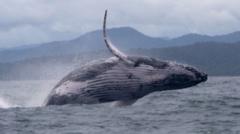The remarkable journey of a humpback whale spanning over 13,000 km reveals changing ocean patterns and potential threats to marine ecosystems.
**Humpback Whale's Unprecedented Journey Caught on Camera: A Climate Change Odyssey**

**Humpback Whale's Unprecedented Journey Caught on Camera: A Climate Change Odyssey**
A stunning migration of a humpback whale illustrates the impact of climate change on marine life.
The latest findings reveal a truly remarkable event in the natural world: a humpback whale has traveled one of the longest recorded distances ever observed for its species, raising eyebrows among scientists regarding the implications of climate change. This incredible marine creature was first spotted off the Pacific coast of Colombia in 2017 and, astonishingly, reappeared several years later near Zanzibar in the Indian Ocean, marking a staggering journey of at least 13,000 kilometers.
Experts speculate this epic voyage may be linked to the repercussions of climate change that are affecting marine food sources, prompting whales to venture farther in search of sustenance or potentially in pursuit of new mating opportunities. Ekaterina Kalashnikova from the Tanzania Cetaceans Program expressed amazement at the whale’s journey, stating that it is “truly impressive and unusual” for such a migratory species.
Kalashnikova posits that this individual’s journey could represent the longest migration ever recorded for a humpback whale. Each year, these majestic creatures traverse vast distances, moving from warmer breeding grounds to cooler feeding areas. However, this particular whale's odyssey involved the exploration of two very disparate breeding regions, a feat that could suggest significant environmental shifts at play.
One critical theory postulates that climate change is modifying the availability of essential foods such as krill, compelling whales to navigate longer distances in search of adequate nourishment. Conversely, it’s also possible that these marine giants are seeking new breeding areas as whale populations begin to recover thanks to global conservation initiatives.
While the precise motivations behind this whale's unusual journey remain unclear, factors such as climate change, an uptick in extreme environmental events, and evolutionary adaptations could all contribute to these migratory changes, according to Dr. Kalashnikova.
The male humpback whale was photographed as part of a research project focused on identifying whale movements using citizen scientists across the globe. That effort culminated in a detailed analysis reliant on hundreds of thousands of images submitted to the user-friendly platform happywhale.com, which employs artificial intelligence to track and match the unique patterns of whale tails. The results of this research have been published in the Royal Society Open Science journal.
As marine scientists continue to unravel the complex relationship between climate shifts and whale behavior, this extraordinary journey serves as a vivid reminder of the need for ongoing conservation efforts and a deeper understanding of how climate change affects our oceans.
Experts speculate this epic voyage may be linked to the repercussions of climate change that are affecting marine food sources, prompting whales to venture farther in search of sustenance or potentially in pursuit of new mating opportunities. Ekaterina Kalashnikova from the Tanzania Cetaceans Program expressed amazement at the whale’s journey, stating that it is “truly impressive and unusual” for such a migratory species.
Kalashnikova posits that this individual’s journey could represent the longest migration ever recorded for a humpback whale. Each year, these majestic creatures traverse vast distances, moving from warmer breeding grounds to cooler feeding areas. However, this particular whale's odyssey involved the exploration of two very disparate breeding regions, a feat that could suggest significant environmental shifts at play.
One critical theory postulates that climate change is modifying the availability of essential foods such as krill, compelling whales to navigate longer distances in search of adequate nourishment. Conversely, it’s also possible that these marine giants are seeking new breeding areas as whale populations begin to recover thanks to global conservation initiatives.
While the precise motivations behind this whale's unusual journey remain unclear, factors such as climate change, an uptick in extreme environmental events, and evolutionary adaptations could all contribute to these migratory changes, according to Dr. Kalashnikova.
The male humpback whale was photographed as part of a research project focused on identifying whale movements using citizen scientists across the globe. That effort culminated in a detailed analysis reliant on hundreds of thousands of images submitted to the user-friendly platform happywhale.com, which employs artificial intelligence to track and match the unique patterns of whale tails. The results of this research have been published in the Royal Society Open Science journal.
As marine scientists continue to unravel the complex relationship between climate shifts and whale behavior, this extraordinary journey serves as a vivid reminder of the need for ongoing conservation efforts and a deeper understanding of how climate change affects our oceans.



















